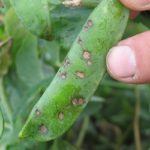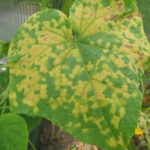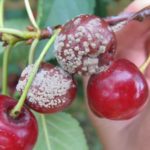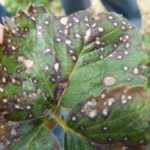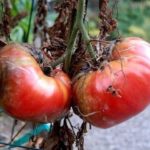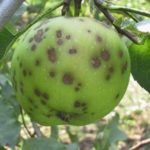The plans of each gardener is measures to prevent plants from fungal diseases. One of the most affordable tools used for treatments is copper sulphate. The effectiveness of its use, instructions and rules for preparing a working solution from phytophthora will be discussed in this article.
Table of contents
In what cases resort to copper sulphate?
For many decades to a series of copper sulphate does not lose its relevance in gardening works. It is used as protection of cultures against fungal infections:
- scab;
- white spot;
- ascohitosis;
- monilioz;
- downy mildew;
- phytophthora and other diseases.
- Ascohitosis
- Downy mildew
- Monilioz
- Signs of white spot
- Late blight
- Scab Aged Apple
In addition to prophylactic purposes, the tool is used for foliar dressings. Often, plants growing on acidified, sandy or peat soils are deficient in copper. 1-2 treatments are enough to compensate for the lack of trace elements in the soil.
Pre-sowing works usually begin with soil disinfection. As an option in this case, use a solution of copper sulfate. Also, the tool acts as an antiseptic for wooden structures. Spraying the tree prevents the formation of mold or mildew. This method is often used by gardeners in the arrangement of greenhouses or other garden structures.
Advantages and disadvantages of using
The main advantage of copper sulfate is that the active substances of the agent remain after spraying on the surface of the plant, without being absorbed into the greens and fruits. Thanks to this, it is possible to get a crop that is safe for people. Among other benefits:
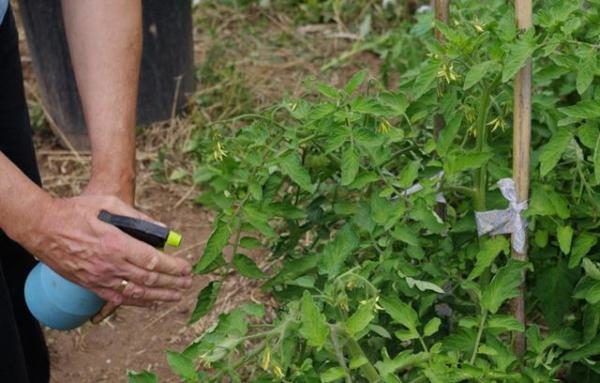
- simple technology of use;
- affordable price;
- low toxicity (harmful substances decompose in a few days);
- when properly applied no side effects;
- composition enriches plants iron;
- multiple treatments not addictive in fungi and bacteria.
Insecticide is scientifically effective against phytophthora due to its high copper content. It is used in the manufacture of other products for the garden. Any arguments about the toxicity of a substance are based only on an unjustified increase in its dosage.The effect after correct treatment of the beds persists for 2 weeks, and the effect of the active components begins within a couple of hours.
The disadvantages of copper sulfate are still there, even though the drug has been tested by several generations of gardeners. In the old days, when there was practically no choice of insecticides, a blue liquid was used in every household. Now it is easy to find an alternative, especially since there are compounds based on biological substances on the market. Their use is considered absolutely safe, unlike copper solution. It should also be remembered that the working fluid can burn out the plants or make the fruits unfit for consumption if you increase the amount of crystalline powder.
Instructions for use for tomatoes and other plants
To prepare the working solution, it is necessary to dissolve the blue crystals in water. Means in quantity 50 gram diluted first in a small amount of liquid, then after thorough mixing, bring the total volume to 5 l Properties of active substances persist throughout the day. The dissolved vitriol is not subject to long-term storage, therefore it is recommended to prepare a new portion immediately before use.
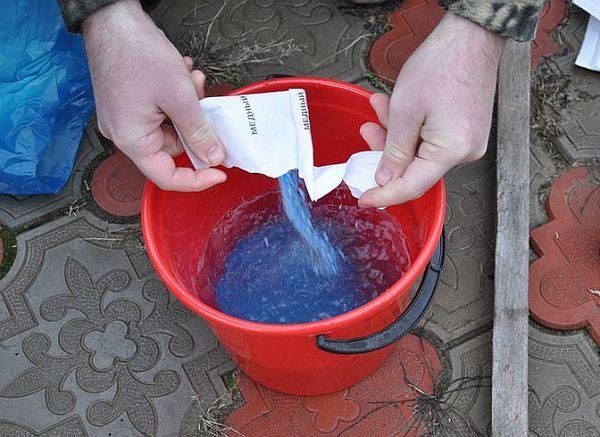
The presence of toxins requires taking precautions when spraying liquids:
- spray far from water and livestock;
- if there are bees, Do not let them out of the hives on the day of the work.
Plants need to be processed in the evening or early in the morning in dry weather. If there is a threat of precipitation, it is better to postpone the work to another day (the effect disappears if it rains during 4 hours).
Experienced gardeners are advised to perform phytophthora prevention activities in several stages.
- The first stage is carried out at the stage of preparing the soil for sowing seedlings. The soil is moistened with a spray with a 3% solution of copper sulphate. Do it once.
- The second stage is carried out at the pickling stage of seedlings. A day before transferring the seedlings to individual containers, the soil is moistened with a 1% copper-based solution. You should not use more concentrated liquid,as it may have a depressant effect on plants.
- The third stage provides watering holes when planting seedlings in the garden. The consumption rate of funds: 1 liter per 1 hole. Later Bordeaux liquid sprayed the plants at the stage of formation of the fruit. The concentration of copper sulfate for the green part of the crop should not exceed 0.1-0.2%, otherwise burns may appear on the leaves.
Security measures when working with the tool
When working with copper sulphate, it is necessary to wear gloves and goggles to protect the skin and mucosa from direct contact with the solution. When carrying out processing it is impossible to use water and food, and also to smoke. In case of contact with the open areas of the skin or mucous membrane, it is recommended to immediately wash the affected area with plenty of water.
An insecticide is a chemical, therefore when using it in the household, you should follow some rules:
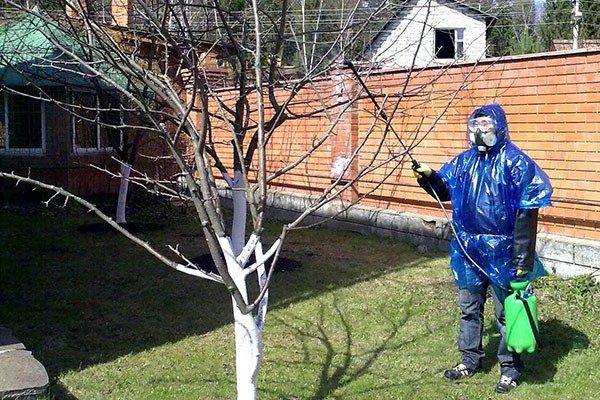
- it is necessary to dilute the solution in non-metallic capacity;
- for the quality of the procedure should be apply a brush with a soft long bristle or spray;
- in diluted form the composition retains the properties of the whole 5-6 o'clock;
- during the spraying protect access to animals and children;
- store means need in lockable cabinets inaccessible to children and animals.
Reviews gardeners on the fight against late blight on tomatoes copper sulphate
Alexey Petrovich, 53 years old.For several years I have been growing tomatoes without facing the problem of phytophtoras. I use copper sulphate at least 3 times per season. The first time I disinfect the seeds, the second time 1 l per well before planting the seedlings, the third time before flowering as a top-dressing.
Anastasia, 36 years old. I water the soil with a solution of copper sulphate before each planting, but the tomatoes are still affected by blight. Means I cook correctly, I adhere to the rules of watering. Maybe something else missed or copper sulfate is not so effective?
Timur, 46 years old. Copper sulphate in the household is the first mate.In the greenhouse, all disinfection is carried out with a blue liquid, the earth is also disinfected with it. Yes, and seeds stand before sowing in a weak solution. Tomatoes are obtained one-on-one, with no signs of late blight.
Vladlen Vitalyevich, 51 year. I have been using copper sulphate for garden work for more than 30 years. I have never purchased drugs based on chemicals because of mistrust and unwillingness to poison the fruits. And I disinfect the soil for seedlings and beds before planting with copper solution, and work on the greenhouse in the spring. The best assistant is hard to find. With phytophthora tomatoes copes as wonderfully as with other tasks. Recommend!
Sophia, 49 years old. I was completely terrified when, after the rain, I discovered brown specks on ripening tomatoes. I didn’t want to remain without a crop, I asked for help from my country house neighbor. She advised to treat twice the bed with a solution of copper sulphate. The tool perfectly coped with the problem. In the farm, as it turned out, the copper-containing drug is an indispensable thing.
When using several types of insecticides at once, it should be remembered that copper sulphate incompatible with alkaline decomposable preparations (for example, organophosphates).

